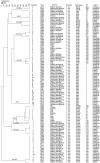Genetic characteristics of pathogenic Leptospira in wild small animals and livestock in Jiangxi Province, China, 2002-2015
- PMID: 31233503
- PMCID: PMC6611636
- DOI: 10.1371/journal.pntd.0007513
Genetic characteristics of pathogenic Leptospira in wild small animals and livestock in Jiangxi Province, China, 2002-2015
Abstract
Background: Leptospirosis is one of the most important neglected tropical bacterial diseases worldwide. However, there is limited information on the genetic diversity and host selectivity of pathogenic Leptospira in wild small mammal populations.
Methodology/principal findings: Jiangxi Province, located in southern China, is a region highly endemic for leptospirosis. In this study, among a total of 3,531 trapped rodents dominated by Apodemus agrarius (59.7%), 330 Leptospira strains were successfully isolated from six different sites in Jiangxi between 2002 and 2015. Adding 71 local strains from humans, various kinds of livestock and wild animals in Jiangxi, a total of 401 epidemic strains were characterized using 16S rRNA gene senquencing, multilocus sequence typing (MLST) and the microscopic agglutination test (MAT). Among them, the most prevalent serogroup was Icterohaemorrhagiae (61.10%), followed by Javanica (19.20%) and Australis (9.73%); the remaining five serogroups, Canicola, Autumnalis, Grippotyphosa, Hebdomadis and Pomona, accounted for 9.97%. Species identification revealed that 325 were L. interrogans and 76 were L. borgpetersenii. Moreover, L. interrogans was the only pathogenic species in Fuliang and Shanggao and was predominant in Shangrao (95.0%); L. borgpetersenii was the most common in the remaining three sites. Twenty-one sequence types (STs) were identified. Similarly, ST1 and serogroup Icterohaemorrhagiae were most prevalent in Shangrao (86.0% and 86.4%) and Fuliang (90.4% and 90.4%), ST143 and serogroup Javanica in Shangyou (88.5% and 90.4%) and Longnan (73.1% and 73.1%), and ST105 and serogroup Australis in Shanggao (46.3% and 56.1%). Serogroup Icterohaemorhagiae primarily linked to A. agrarius (86.9%), serogroup Canicola to dogs (83.3%). There were significant differences in the distribution of leptospiral species/serogroups/STs prevalence across host species/collected locations among the 394 animal-associated strains (Fisher's exact test, p<0.001).
Conclusions/significance: Our study demonstrated high genetic diversity of pathogenic Leptospira strains from wild small animals in Jiangxi from 2002 to 2015. A. agrarius was the most abundantly trapped animal reservoir, and serogroup Icterohaemorrhagiae and ST1 were the most dominant in Jiangxi. Significant geographic variation and host diversity in the distribution of dominant species, STs and serogroups were observed. Moreover, rat-to-human transmission might play a crucial role in the circulation of Leptospirosis in Jiangxi. Details of the serological and molecular characteristics circulating in this region will be essential in implementing prevention and intervention measures to reduce the risk of disease transmission in China. However, phylogenetic analysis of more Leptospira isolates should explore the impact of ecological change on leptospirosis transmission dynamics and investigate how such new knowledge might better impact environmental monitoring for disease control and prevention at a public health level.
Conflict of interest statement
The authors have declared that no competing interests exist.
Figures



Similar articles
-
Serological and molecular characteristics of pathogenic Leptospira in rodent populations in Fujian Province, China, 2018-2020.BMC Microbiol. 2022 Jun 7;22(1):151. doi: 10.1186/s12866-022-02566-2. BMC Microbiol. 2022. PMID: 35672661 Free PMC article.
-
Molecular Typing of Pathogenic Leptospira Serogroup Icterohaemorrhagiae Strains Circulating in China during the Past 50 Years.PLoS Negl Trop Dis. 2015 May 19;9(5):e0003762. doi: 10.1371/journal.pntd.0003762. eCollection 2015 May. PLoS Negl Trop Dis. 2015. PMID: 25993109 Free PMC article.
-
Circulating genotypes of Leptospira in French Polynesia : An 9-year molecular epidemiology surveillance follow-up study.PLoS Negl Trop Dis. 2020 Sep 28;14(9):e0008662. doi: 10.1371/journal.pntd.0008662. eCollection 2020 Sep. PLoS Negl Trop Dis. 2020. PMID: 32986693 Free PMC article.
-
Epidemiology of leptospirosis in Tanzania: A review of the current status, serogroup diversity and reservoirs.PLoS Negl Trop Dis. 2021 Nov 16;15(11):e0009918. doi: 10.1371/journal.pntd.0009918. eCollection 2021 Nov. PLoS Negl Trop Dis. 2021. PMID: 34784354 Free PMC article.
-
A review of leptospirosis in Malaysia.Vet Res Commun. 1988;12(2-3):179-89. doi: 10.1007/BF00362799. Vet Res Commun. 1988. PMID: 3055663 Review.
Cited by
-
Influence of Season, Population and Individual Characteristics on the Prevalence of Leptospira spp. in Bank Voles in North-West Germany.Biology (Basel). 2021 Sep 18;10(9):933. doi: 10.3390/biology10090933. Biology (Basel). 2021. PMID: 34571810 Free PMC article.
-
Molecular Typing of Pathogenic Leptospira Species Isolated from Wild Mammal Reservoirs in Sardinia.Animals (Basel). 2021 Apr 13;11(4):1109. doi: 10.3390/ani11041109. Animals (Basel). 2021. PMID: 33924303 Free PMC article.
-
Weil's Disease-Immunopathogenesis, Multiple Organ Failure, and Potential Role of Gut Microbiota.Biomolecules. 2022 Dec 7;12(12):1830. doi: 10.3390/biom12121830. Biomolecules. 2022. PMID: 36551258 Free PMC article. Review.
-
Seroepidemiological Analysis of Canine Leptospira Species Infections in Changchun, China.Pathogens. 2023 Jul 12;12(7):930. doi: 10.3390/pathogens12070930. Pathogens. 2023. PMID: 37513777 Free PMC article.
-
Comparative genomic analysis of Chinese human leptospirosis vaccine strain and circulating isolate.Hum Vaccin Immunother. 2020 Jun 2;16(6):1345-1353. doi: 10.1080/21645515.2020.1720439. Epub 2020 Feb 11. Hum Vaccin Immunother. 2020. PMID: 32045318 Free PMC article.
References
-
- Costa F, Wunder EA Jr., De Oliveira D, Bisht V, Rodrigues G, Reis MG, et al. Patterns in Leptospira Shedding in Norway Rats (Rattus norvegicus) from Brazilian Slum Communities at High Risk of Disease Transmission. PLoS Negl Trop Dis. 2015;9(6):e0003819 10.1371/journal.pntd.0003819 ; - DOI - PMC - PubMed
Publication types
MeSH terms
LinkOut - more resources
Full Text Sources

